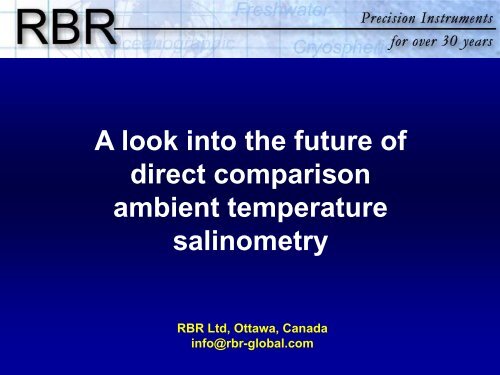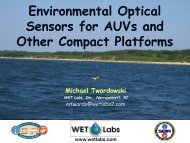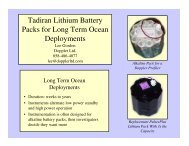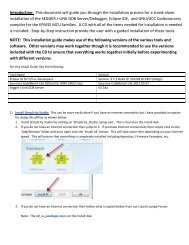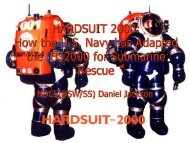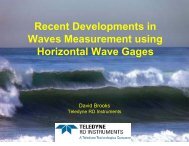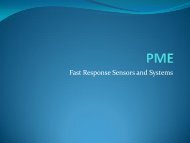2007-01 STF - Geleynse - RBR.pdf
2007-01 STF - Geleynse - RBR.pdf
2007-01 STF - Geleynse - RBR.pdf
- No tags were found...
Create successful ePaper yourself
Turn your PDF publications into a flip-book with our unique Google optimized e-Paper software.
Why Salinometry?Salinity is a key property of seawater from whichdensity and sound speed may be derived; theseare fundamental to ocean science andclimatology.Salinometers provide a reference to the widelyaccepted Practical Salinity Scale.
Standard MethodCTD & Water Samples AutoSAL
Limitations• Temperature stabilized environment• Sequential standardization• Skilled staff• SSW is expensive• Warming samples may change apparent salinity
The Future…now- High Performance- Easy to Use- Operates at in situtemperatures- Small size
Concepts of the Small Salinometer:1. Direct comparison of conductivity of sample andstandard2. Direct reading of R t over wide temperature range
Previous works(b) Ukraine – SevastopolInductive method(a) China – Tienjin. in Collaborationwith Tim Dauphinee, NSERC CanadaTwo conductive cells
Dual chamberInductive systemBased on standard<strong>RBR</strong> technology
Dual Chamber principleOil BathFluid outletsSample CellReference CellFluid inlets
Concepts of the Small Salinometer:1. Direct comparison of conductivity of sample and standard2. Direct reading of R t over wide temperature range
Salinometers measure R tPractical Salinity Scale - 1978
Test ResultsMS-310 Repeatability Using Samples of Constant Salinity2534.9022434.900T °C23TemperatureSalinity34.898Salinity psu2234.8962110:32:00 12:00:00 12:48:00 13:36:00 15:14:00 16:15:00time34.894
Test ResultsCalibration of Temperature SensorResiduals Versus TemperatureResiduals °C0.0<strong>01</strong>00.00050.0000-0.0005-0.0<strong>01</strong>00 5 10 15 20 25 30 35Temperature °C
Test ResultsR t variation with temperature for samples of Standard Seawater
Test ResultsMS-310 and AutoSal 8400B against OSIL Linearity pack (1 trial)
Salinometer Drift Comparison0.0035Figure 4. D298 Autosal and MS-310 standardization drift0.003dS=Sssw(end)-Sssw(start), PSS-780.00250.0020.0<strong>01</strong>50.0<strong>01</strong>0.00050-0.00051 2 3 4 6 8 12 16 19 22 25 27 30 32 35 39 42 45 47 50 53 56 60 63-0.0<strong>01</strong>-0.0<strong>01</strong>5Autosal driftStation numbersMS-310 drift
Performance data compared with PortaSal and AutoSalRangeAutoSal8400B0.00<strong>01</strong> to1.15PortaSal8410A0.00<strong>01</strong> to1.15MicroSalMS-3100.00<strong>01</strong> to2.00 RtAccuracy 0.002 0.003 0.002 psuResolution 0.0002 0.0003 0.0002 PsuRoom Temp +0°; -2° +0°; -2° 15° to 30° CBath 16.8 9 2 LitresWeight 70 29 5 kgPower 400 200 10 wattsSupply Voltage 110/220 AC 110/220 AC 12 DC volts
Easy to useMS-310 User InterfaceWindows ® -basedcontrol panel streamlinesAnd simplifies operation
Small Size• 280mm x 280mm x 180mm•5kg• 12VDC
What else can I do with the MS-310?• Thermosalinograph• Measure other fluids (guacamole?)• Immerse in bath for direct calibration of CTDs• Autosamplers• Submersible ocean salinometer (ZEFICC)• Investigate behaviour of seawater types
Characterization of various seawater types over temperature rangeDec06-Jan07 Different waters vs IAPSO SSW Salinity-Temperature test residuals0.05000.04000.0300dS=Ssample-Sssw, PSS-780.02000.<strong>01</strong>000.00000 5 10 15 20 25 30-0.<strong>01</strong>00-0.0200SSW Pacific seawater Test bath Salt water PEI seawater-0.0300Temperature, deg.C
ConclusionsThe MS-310 represents the future of scientific salinity measurement, allowingmeasurement of salinity samples directly after CTD retrieval, outside the lab; thenearest thing to in situ salinometry.This offers a new perspective for understanding the nature of the conductivitymeasurements of seawater and opens doors beyond the PSS-78.Water samples should not have to be adjusted to a salinometer’s comfortconditions, rather the salinometer should adjust to the CTD measurementconditions – this is the future of salinity technology


